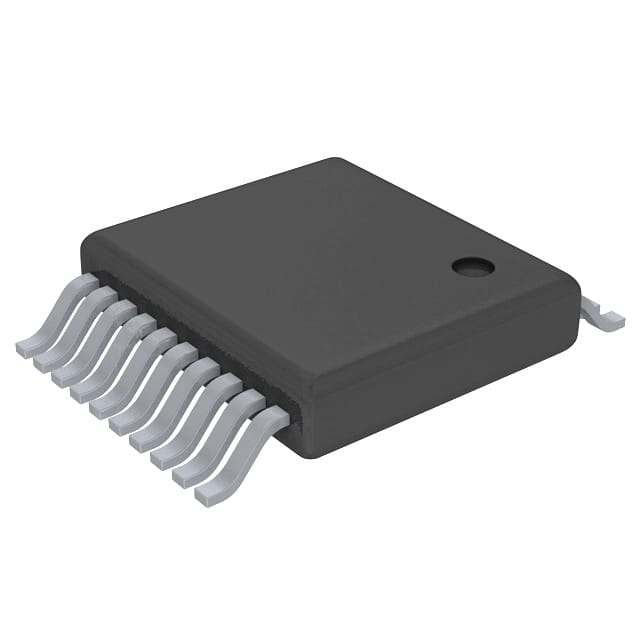Vedi le specifiche per i dettagli del prodotto.

PCA9544ADGVR
Product Overview
- Category: Integrated Circuit
- Use: I2C Multiplexer
- Characteristics: Low-voltage, 4-channel, I2C-bus multiplexer with reset
- Package: VSSOP-10
- Essence: The PCA9544ADGVR is a multiplexer that allows multiple I2C devices to share the same I2C bus.
- Packaging/Quantity: Tape and Reel, 3000 units per reel
Specifications
- Supply Voltage: 1.65V to 5.5V
- Operating Temperature Range: -40°C to +85°C
- I2C Bus Compatibility: Standard-mode, Fast-mode, Fast-mode Plus, and High-speed mode
- Channel Selection: Controlled via I2C-bus interface or dedicated enable pins
- Reset Function: Individual channel reset capability
- Low Standby Current: Less than 1µA
Pin Configuration
The PCA9544ADGVR has a total of 10 pins in the VSSOP package:
- SDA (Serial Data)
- SCL (Serial Clock)
- EN0 (Enable Channel 0)
- EN1 (Enable Channel 1)
- EN2 (Enable Channel 2)
- EN3 (Enable Channel 3)
- GND (Ground)
- NC (No Connection)
- VCC (Supply Voltage)
- RST (Reset)
Functional Features
- Allows multiple I2C devices to be connected to a single I2C bus
- Enables communication with individual devices by selecting specific channels
- Supports various I2C bus speeds for compatibility with different devices
- Provides individual channel reset capability for troubleshooting
- Low standby current ensures power efficiency
Advantages and Disadvantages
Advantages
- Simplifies I2C bus management by reducing the number of required bus lines
- Enables efficient utilization of limited I2C bus resources
- Supports a wide range of supply voltages for compatibility with different systems
- Individual channel reset capability aids in debugging and fault isolation
Disadvantages
- Limited to 4 channels, may not be suitable for applications requiring more channels
- Requires additional control logic to select channels via I2C-bus interface
Working Principles
The PCA9544ADGVR operates by multiplexing the I2C bus signals. It uses an internal switch matrix to connect one of the four input channels to the output channel, which is connected to the I2C bus. The selection of the active channel can be controlled either through the I2C-bus interface or by using the dedicated enable pins.
When a specific channel is selected, the corresponding I2C device connected to that channel becomes accessible on the I2C bus. This allows multiple devices to share the same I2C bus while avoiding conflicts and ensuring proper communication.
Detailed Application Field Plans
The PCA9544ADGVR finds applications in various scenarios where multiple I2C devices need to be connected to a single I2C bus. Some common application fields include:
- Embedded Systems: Allows multiple sensors, actuators, and other peripherals to communicate with a microcontroller using a single I2C bus.
- Industrial Automation: Enables efficient management of I2C-based devices in industrial control systems, reducing wiring complexity.
- Consumer Electronics: Facilitates the integration of multiple I2C devices, such as displays, touch controllers, and audio codecs, in smartphones, tablets, and other consumer electronic devices.
- Automotive Electronics: Helps streamline the connection of various I2C devices in automotive applications, such as infotainment systems, climate control modules, and advanced driver-assistance systems.
Detailed and Complete Alternative Models
- PCA9543ADGVR: Similar to PCA9544ADGVR but with 3 channels instead of 4.
- TCA9548A: An 8-channel I2C multiplexer with similar functionality.
- TS5A23157: A dual-channel bidirectional I2C bus switch for more specific applications.
These alternative models provide different channel configurations and features, allowing users to choose the most suitable option based on their requirements.
Word count: 511 words
10 domande e risposte comuni relative all'applicazione di PCA9544ADGVR nelle soluzioni tecniche
Sure! Here are 10 common questions and answers related to the application of PCA9544ADGVR:
Q: What is PCA9544ADGVR? A: PCA9544ADGVR is a multiplexer/demultiplexer IC (Integrated Circuit) that allows multiple I2C devices to share the same I2C bus.
Q: How many channels does PCA9544ADGVR support? A: PCA9544ADGVR supports 4 channels, allowing up to 4 different I2C devices to be connected to a single I2C bus.
Q: How does PCA9544ADGVR help in technical solutions? A: PCA9544ADGVR helps in reducing the number of I2C buses required in a system, simplifying the design and reducing costs.
Q: Can PCA9544ADGVR be used to connect multiple I2C master devices? A: Yes, PCA9544ADGVR can be used to connect multiple I2C master devices to a single I2C bus, enabling communication with multiple slave devices.
Q: How do I select a specific channel on PCA9544ADGVR? A: The channel selection is done by writing to the control register of PCA9544ADGVR using the I2C protocol.
Q: What is the maximum frequency supported by PCA9544ADGVR? A: PCA9544ADGVR supports a maximum I2C bus frequency of 400 kHz.
Q: Can PCA9544ADGVR be cascaded to support more than 4 channels? A: Yes, multiple PCA9544ADGVR ICs can be cascaded together to support more than 4 channels, allowing for even more I2C devices to be connected.
Q: Does PCA9544ADGVR require external pull-up resistors? A: Yes, PCA9544ADGVR requires external pull-up resistors on the I2C bus lines for proper operation.
Q: Can PCA9544ADGVR be used in both 3.3V and 5V systems? A: Yes, PCA9544ADGVR is compatible with both 3.3V and 5V systems, making it versatile for various applications.
Q: Are there any limitations or considerations when using PCA9544ADGVR? A: One limitation is that PCA9544ADGVR does not support clock stretching by slave devices. Additionally, care should be taken to avoid bus contention when multiple masters access the same channel simultaneously.
Please note that these answers are general and may vary depending on the specific application and requirements. It's always recommended to refer to the datasheet and consult the manufacturer for detailed information.

